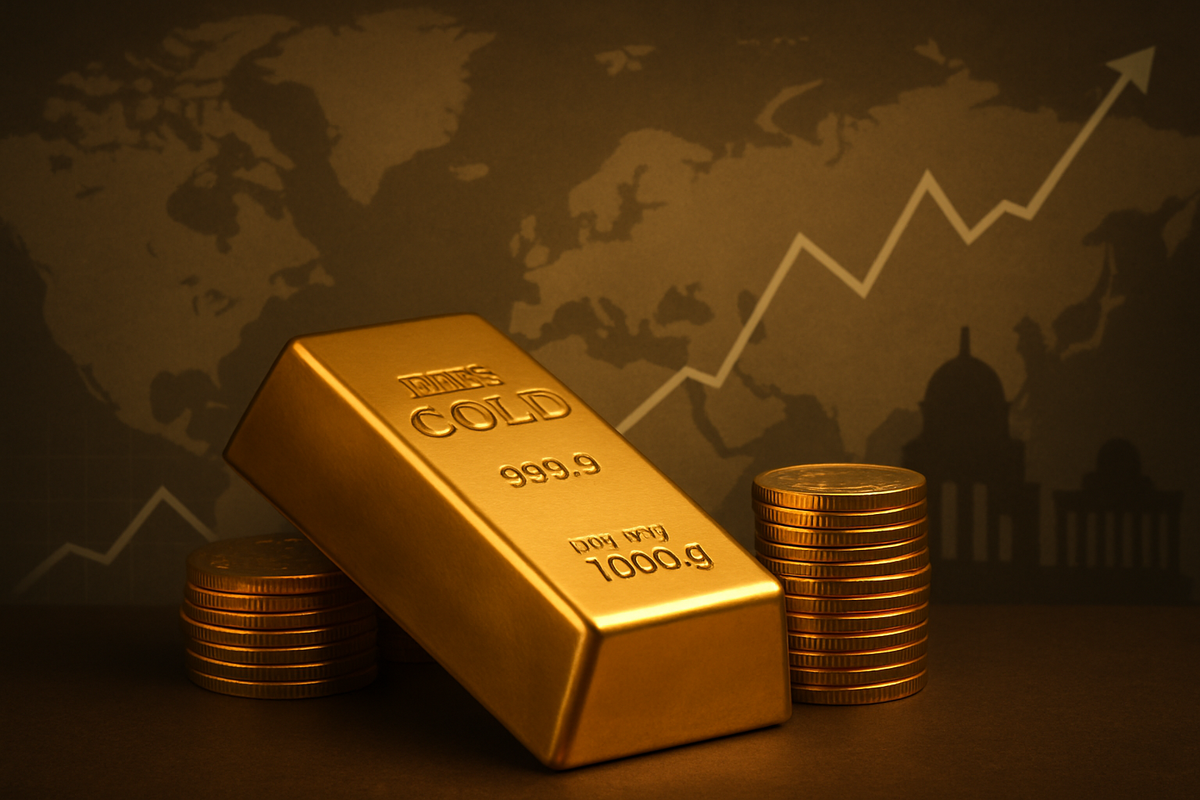
Gold, the age-old safe haven, is experiencing a remarkable resurgence, pushing its price towards and, in some instances, beyond historic highs. As of October 3, 2025, the precious metal is trading robustly, hovering around $3,894 to $3,901 per ounce. This significant rally is not merely a fleeting market fluctuation but rather a reflection of deep-seated macroeconomic shifts, escalating geopolitical tensions, and a profound change in investor sentiment, signaling a new era for the yellow metal.
This bullish momentum carries immediate implications for investors, reinforcing gold's critical role as a portfolio diversifier and a formidable hedge against economic volatility and inflationary pressures. The sustained upward trajectory suggests that gold is not just reacting to current events but is actively carving out a new, elevated position in the global financial landscape, prompting a re-evaluation of its strategic importance in investment portfolios worldwide.
A Resurgent Rally: Gold's Path to Unprecedented Heights
Gold's journey to its current elevated status has been nothing short of spectacular, building significant momentum throughout 2024 and accelerating into 2025. The metal climbed approximately 25% in 2024, hitting 40 new all-time highs and peaking at roughly US$2,778 per ounce by late October. This strong foundation propelled gold past the psychological US$3,000 per ounce barrier for the first time on record in March 2025. Further gains saw it reach US$3,500 per ounce in April amidst unpredictable U.S. trade policies and surge past US$3,800 an ounce by September 2025, nearly doubling its price from US$2,000 per ounce at the start of 2024.
Several powerful factors are fueling this sustained bullish sentiment. Geopolitical uncertainty, including ongoing conflicts in Ukraine and the Middle East, alongside heightened trade tensions and an unpredictable U.S. foreign policy, has significantly amplified gold's traditional appeal as a safe-haven asset. Simultaneously, central banks globally are diversifying their reserves at a historic pace, actively accumulating gold to reduce reliance on the U.S. dollar and mitigate risks from shifting geopolitical alliances, with purchases forecasted to average around 900 tonnes in 2025. Persistent inflationary pressures, coupled with expectations of lower interest rates from major central banks like the Federal Reserve, further diminish the opportunity cost of holding non-yielding gold, making it an increasingly attractive asset. The weakening U.S. dollar also plays a role, making gold cheaper for international buyers and stimulating demand.
Investor sentiment has become overwhelmingly positive, drawing substantial inflows into gold Exchange Traded Fund (ETF) strategies, which reached US$12.4 billion in March 2025—the highest monthly total since 2020. This institutional and retail interest, often driven by a "fear of missing out" (FOMO), has further propelled prices. Adding to the demand-side strength, concerns about global economic health, particularly the increasing U.S. debt-to-GDP ratio (exceeding 135%), create a favorable macroeconomic environment for gold. On the supply side, global mine production saw a 3% decline in 2024, coupled with deteriorating ore quality, contributing to tighter supply. Moreover, weakness in China's property sector has driven Chinese investors to seek gold as an alternative safe haven, providing another significant boost to demand.
Beneficiaries and Market Movers in a Golden Era
The surging price of gold creates a clear hierarchy of winners in the financial markets, with gold mining companies standing out as primary beneficiaries. Companies with strong balance sheets, efficient operations, and low production costs are particularly well-positioned to capitalize on higher metal prices. Increased revenue and improved profit margins are expected to translate into higher stock valuations and potentially increased dividends for shareholders. Examples include major players like Barrick Gold Corp. (NYSE: GOLD), Newmont Corp. (NYSE: NEM), and Agnico Eagle Mines Ltd. (NYSE: AEM), which are likely to see enhanced financial performance. Mid-tier and junior miners exploring new deposits or expanding existing operations could also attract significant investor interest.
Beyond the direct mining sector, the bullish gold market also creates opportunities for financial institutions offering gold-backed investment products such as Exchange Traded Funds (ETFs) and futures contracts. Increased investor demand for these instruments translates into higher trading volumes and management fees. Furthermore, countries with substantial gold reserves, particularly those central banks actively accumulating gold, see their national wealth and financial stability bolstered. While direct "losers" are less explicit in a rising gold market, companies heavily reliant on a stable, lower-cost commodity environment might face indirect pressures if gold's price strength signals broader inflationary trends affecting other raw materials. However, the overall sentiment is overwhelmingly positive for entities directly involved in the gold ecosystem.
Gold's Broader Implications: A Shifting Global Financial Landscape
Gold's robust rally is not an isolated event but rather a significant indicator of broader, evolving industry trends and geopolitical realignments. The accelerated pace of central bank gold accumulation underscores a global movement towards de-dollarization and a desire to diversify national reserves away from over-reliance on any single fiat currency. This trend has profound ripple effects, potentially influencing the stability and relative strength of major currencies and commodity markets. As central banks continue to buy, it signals a systemic shift in how nations perceive and manage financial risk in an increasingly uncertain world.
The event also highlights gold's enduring role as a hedge against inflation and economic instability. In an environment of persistent, albeit cooling, inflation and growing concerns about global economic health—particularly the sustainability of sovereign debt, such as the rising U.S. debt-to-GDP ratio—gold provides a tangible store of value. Historically, gold has performed well during periods of economic uncertainty and currency devaluation, and the current rally reinforces this precedent. Regulatory or policy implications could arise as governments and international bodies grapple with the implications of widespread de-dollarization and the potential for a more multi-polar reserve currency system. This shift could lead to new trade agreements, financial regulations, and even new digital currency initiatives designed to reduce reliance on traditional global reserve assets. The current scenario draws parallels to historical periods of geopolitical tension and economic upheaval, where gold consistently emerged as a preferred asset, affirming its timeless appeal in times of crisis.
What Lies Ahead: Navigating the Golden Horizon
Looking ahead, the short-term and long-term possibilities for gold remain largely bullish, though tempered with a degree of caution following such significant gains. Many analysts, including Goldman Sachs Research, project gold could reach $3,700 per troy ounce by the end of 2025, with potential to hit $3,880 in the event of a recession. Other forecasts are even more optimistic, suggesting prices could surpass $4,000 per ounce by 2026 or later, especially if the current macroeconomic and geopolitical conditions persist. The ongoing geopolitical tensions and the continued trend of central bank diversification are likely to provide a strong floor for gold prices, limiting significant downside risks.
Potential strategic pivots for investors include increasing exposure to gold mining stocks, particularly those with strong fundamentals and proven reserves, as they offer leveraged exposure to rising gold prices. Market opportunities may also emerge in related sectors, such as precious metals streaming and royalty companies, which benefit from mining production without direct operational risks. However, challenges include the inherent volatility of commodity markets and the potential for a reversal in monetary policy, such as unexpected interest rate hikes, which could increase the opportunity cost of holding non-yielding assets like gold. Potential scenarios range from a continued steady ascent driven by sustained demand and geopolitical stability, to more rapid surges if global tensions escalate or if major central banks implement aggressive rate cuts. Investors should also consider the impact of a stronger U.S. dollar, which could temporarily dampen gold's appeal for international buyers.
A Lasting Impact: Gold's Enduring Significance
In summary, gold's recent rebound towards historic highs is a multifaceted event driven by a confluence of geopolitical instability, central bank de-dollarization efforts, inflationary pressures, and robust investor demand. The precious metal has firmly re-established its position as a critical portfolio diversifier and a reliable hedge against market volatility and economic uncertainty. Its performance since 2024 and into 2025 underscores a significant shift in global financial paradigms, where tangible assets are gaining favor amidst a backdrop of unprecedented risk.
Moving forward, the market is likely to remain highly sensitive to geopolitical developments, central bank monetary policies (particularly interest rate decisions from the Federal Reserve), and the trajectory of the U.S. dollar. While the bullish sentiment is expected to persist, investors should approach gold with a balanced perspective, recognizing its role as a long-term store of value and a component of a well-diversified portfolio. The lasting impact of this golden ascent will likely be a renewed appreciation for gold's intrinsic value and its strategic importance in navigating an increasingly complex and unpredictable global financial landscape. Investors should closely monitor global events, central bank communications, and inflation data in the coming months to effectively position their portfolios.
This content is intended for informational purposes only and is not financial advice.





